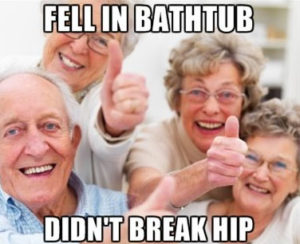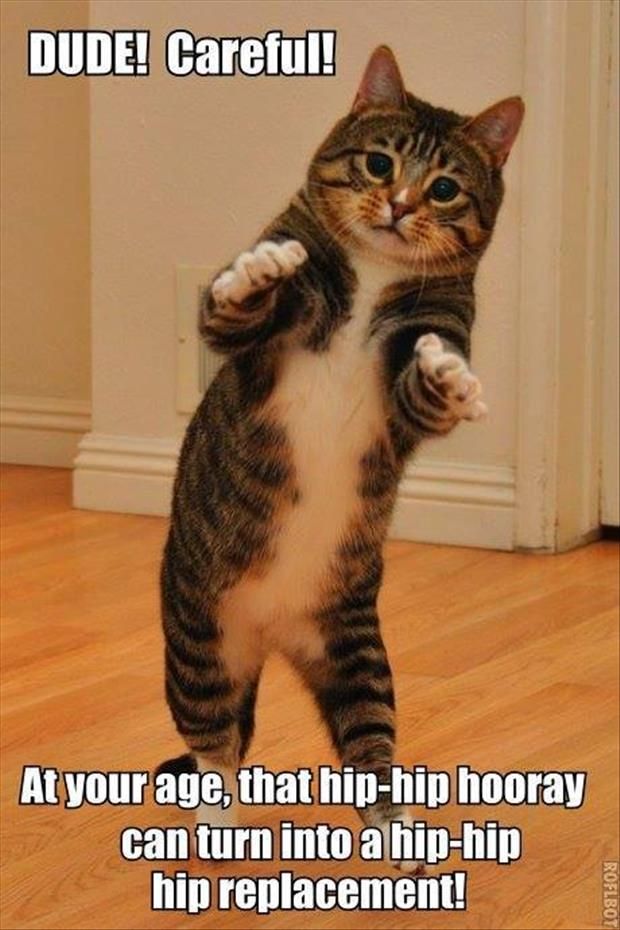Osteoporosis: It’s All About Your Density, Not Your Destiny
 You’ve all heard the jokes about hip fractures and/or hip replacements… An elderly man is told he needs a hip replacement and his wife replies, “He’s never been ‘hip’ a day in his life. How can you replace something he’s never had?”
You’ve all heard the jokes about hip fractures and/or hip replacements… An elderly man is told he needs a hip replacement and his wife replies, “He’s never been ‘hip’ a day in his life. How can you replace something he’s never had?”
Have you ever wondered why hip fractures and replacements are associated with the elderly? Does every old person who falls in the shower then require hip replacement?
It seems that hip fractures and the elderly go hand-in-hand or ball-in-socket…see, your hip is a ball and socket joint…get it? Oh, never mind. However, getting old does NOT, inevitably, lead to a broken hip and its subsequent replacement.
Why do so many elderly folks seem to break various bones, not just their hips? Usually, it comes down to one word: osteoporosis. The next questions then are: what is osteoporosis and how do I avoid it as I age? (I seem to be full of questions today, don’t I?) – see what I did there? Squeezed in two more questions, that’s what. Anyway, osteoporosis is the gradual decreasing of bone density as we age due to a variety of factors. The denser our bones, the stronger they are which increases their ability to fend off injuries, like fractures.
Our bone density peaks around age 25 and is maintained for about ten years. For most people, after age 35, we lose 0.3-0.5% of our bone density per year. However, certain factors can increase that bone loss up to 2-4% per year. Those most at risk for bone loss include Caucasian and Asian females, those with a thin body frame, smokers, those with a family history of osteoporosis, sedentary people, and those with a poor diet lacking in calcium and vitamin D. However, post-menopausal women are most at risk due to their decreased levels of estrogen.
 So, how prevalent is osteoporosis in the U.S.? At least 10 million have osteoporosis while another 34 million have osteopenia, essentially low-grade osteoporosis. Some more sobering stats: 50% of Caucasian women will experience a hip fracture due to osteoporosis in her lifetime. Approximately 20% of those who experience a hip fracture due to osteoporosis will die within a year of the fracture. Only 33% will regain pre-fracture mobility.
So, how prevalent is osteoporosis in the U.S.? At least 10 million have osteoporosis while another 34 million have osteopenia, essentially low-grade osteoporosis. Some more sobering stats: 50% of Caucasian women will experience a hip fracture due to osteoporosis in her lifetime. Approximately 20% of those who experience a hip fracture due to osteoporosis will die within a year of the fracture. Only 33% will regain pre-fracture mobility.
Last question, I promise: How does one prevent the onset of osteoporosis? You probably already know the answer to that question after reading the risk factors. If not, here they are: moderate weight-bearing exercise, like walking. If you smoke, stop. If you’re a heavy drinker, moderate. And of course, ensure you get enough calcium and vitamin D in your diet and/or through supplements.
Most of us require 1,000 mg of calcium per day, but post-menopausal women require 1,500 mg. You can get those milligrams from various dairy products like milk (300 mg in an 8 oz glass), plain yogurt (450 mg in 8 oz), calcium fortified orange juice (300 mg in an 8 oz glass), cheddar cheese (200 mg in a single oz), and cottage cheese (130 mg in one cup). Just think of all the protein you’ll be getting as well. Don’t even get me started on muscle loss as we age!
As for vitamin D, most adults require 600 IU (international units) per day while those over 70 need 800 IU. Sources include fatty fish (mackerel, tuna and salmon have about 450 IU in a 3 oz piece), fortified dairy foods along with orange juice and cereals, beef liver (my dad loved liver and just the smell of it cooking makes me gag), cheese, and egg yolks. We also get vitamin D through sunlight, but that entails other risks, as does eating egg yolks.
Remember, just because we age does NOT mean a broken hip is our destiny. It’s about your bone density which can be maintained by eating properly, getting moderate exercise, not smoking and avoiding slippery tubs and showers at all costs…I jest of course.
You must be logged in to post a comment.